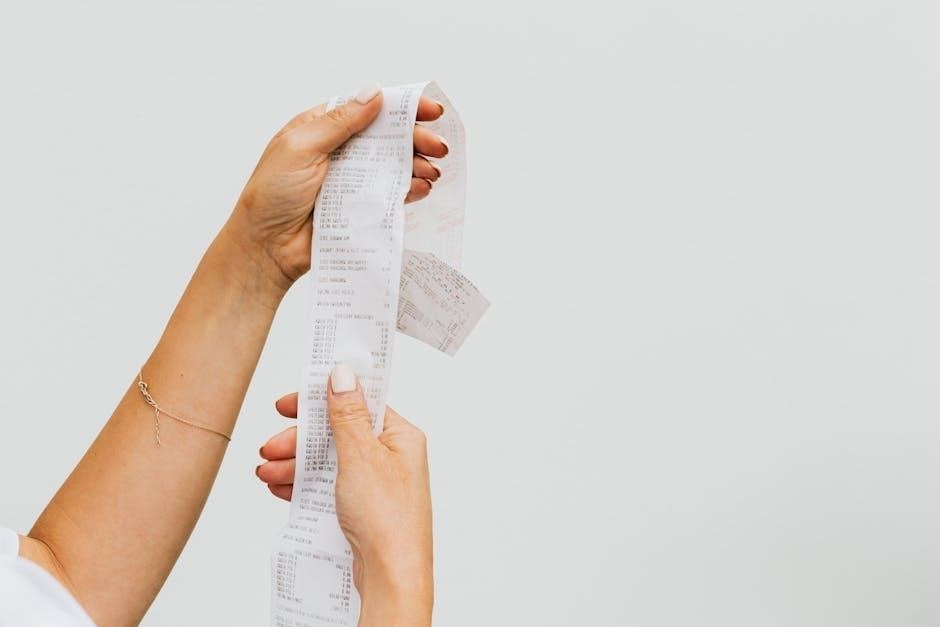manual verification required
Manual verification required is a process used to verify order information, ensuring accuracy and security, typically involving document collection and validation, and is a crucial step in order processing, using
- steps.
Definition and Purpose of Manual Verification
Manual verification is a process that involves manually checking and verifying the authenticity of documents and information, typically as part of a larger process such as order processing or customer onboarding. This process is used to ensure the accuracy and validity of the information provided, and to prevent errors or fraudulent activity. The purpose of manual verification is to provide an additional layer of security and verification, beyond automated systems, to ensure that all information is correct and legitimate. This can involve checking documents such as identification, proof of address, and other relevant information, and verifying that it matches the information provided. By using manual verification, organizations can help to prevent errors, reduce the risk of fraud, and ensure compliance with regulatory requirements. Manual verification is an important step in many processes, and is used to protect both the organization and the customer. It is a critical component of a robust verification system.

Importance of Manual Verification
Manual verification is crucial for security, preventing errors, and ensuring compliance with regulatory requirements, using
proper procedures and protocols;
Security and Regulatory Compliance
Manual verification required plays a significant role in ensuring security and regulatory compliance, as it helps to prevent fraudulent activities and protect sensitive customer information. The process involves verifying the authenticity of documents and identifying potential risks, using various methods such as document validation and authentication. This helps to meet regulatory requirements and prevent non-compliance, which can result in severe penalties and damage to reputation. Many organizations are heavily regulated and required to follow strict rules for KYC and AML compliance, and manual verification is an essential step in this process. By implementing manual verification, businesses can ensure the security and integrity of their operations, and maintain the trust of their customers. The use of manual verification also helps to detect and prevent money laundering and other financial crimes, making it an essential tool for regulatory compliance.
Document Verification Process
Manual verification involves document collection and validation using
- multiple steps.
Collection and Validation of Documents
The collection and validation of documents is a critical step in the manual verification process, typically involving the gathering of identification and proof of address documents.
This process is designed to ensure the authenticity of the documents submitted, and to prevent fraudulent activities.
The validation of documents involves checking the documents for any discrepancies or inconsistencies, and verifying the information contained in the documents against other sources.
This process is typically carried out by trained personnel who are familiar with the different types of documents and the techniques used to verify their authenticity.
The use of technology, such as document scanning and verification software, can also be used to support the validation process, and to help identify any potential issues.
The collection and validation of documents is an important part of the manual verification process, and is used to help prevent fraudulent activities and to protect the interests of all parties involved.

Manual Verification in Order Processing
Manual verification ensures order accuracy and security, using
- steps to validate customer information and prevent errors or fraudulent activities, in the order processing system effectively.
Verification of Order Information
Verification of order information is a critical step in the manual verification process, involving a thorough review of customer data, including names, addresses, and payment details, to ensure accuracy and prevent errors. This process typically involves a team of experts who carefully examine each order to detect any discrepancies or suspicious activity. The verification process may also involve contacting customers to confirm their information or to request additional documentation. By verifying order information, businesses can prevent fraudulent activities, reduce errors, and improve overall customer satisfaction. The use of technology, such as automated verification systems, can also help to streamline the process and improve efficiency. Effective verification of order information is essential for building trust with customers and maintaining a reputation for reliability and security. It is an important aspect of manual verification, and its importance cannot be overstated in today’s digital age.

Communication and Resolution
Customer support teams resolve issues via phone or email, ensuring timely communication and resolution, using
- methods to clarify order details.
Contact and Resolution Process
The contact and resolution process for manual verification required typically involves a team member reaching out to the customer via phone or email to clarify any discrepancies or issues with their order. This process is designed to be efficient and effective, with the goal of resolving any problems quickly and accurately. The customer support team will work with the customer to verify the necessary information, using methods such as document collection and validation to ensure the accuracy of the order. Once the issue has been resolved, the order will be processed and prepared for shipping. The contact and resolution process is an important part of the manual verification required procedure, as it helps to prevent errors and ensure that the customer receives their order in a timely manner. The process is usually straightforward and hassle-free, with the customer support team available to answer any questions or concerns the customer may have.

and Future Developments
Manual verification required will continue to evolve with new technologies and methods, improving efficiency and security, using advanced systems and processes, enhancing customer experience and satisfaction levels greatly always.
Efficiency and Effectiveness of Manual Verification
Manual verification required is a process that ensures the accuracy and security of orders, and its efficiency and effectiveness are crucial in preventing errors and fraud. The use of manual verification helps to reduce the risk of identity theft and other types of fraud, and it also helps to improve the overall customer experience. By using manual verification, companies can ensure that orders are processed correctly and that customers receive their products in a timely manner. The efficiency and effectiveness of manual verification can be improved by using advanced systems and processes, such as automated document verification and validation. This can help to reduce the time and effort required for manual verification, and it can also help to improve the accuracy and security of the process. Overall, the efficiency and effectiveness of manual verification are essential in ensuring the security and integrity of orders, and it is an important part of the order processing cycle.
